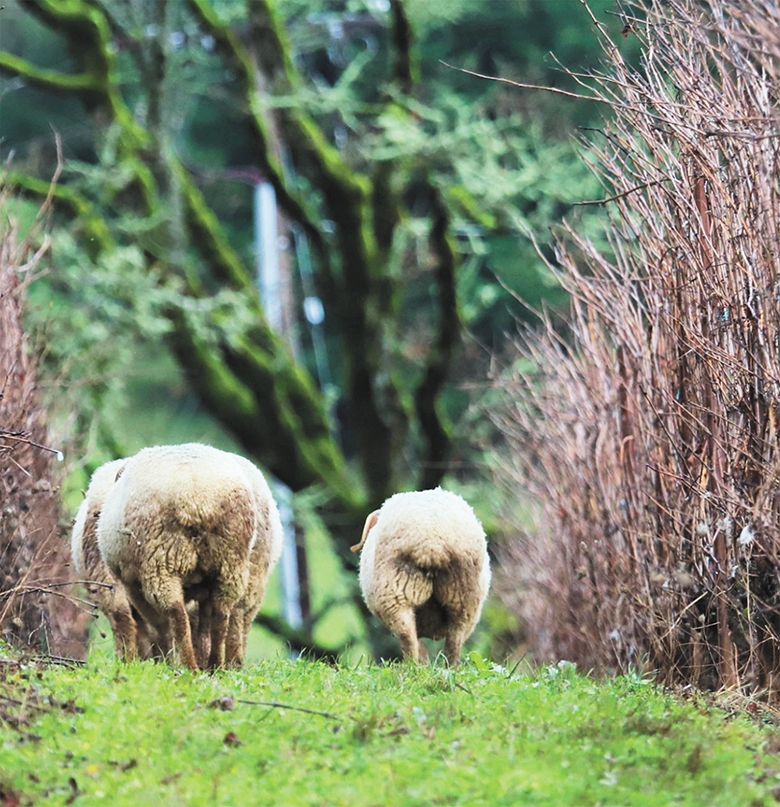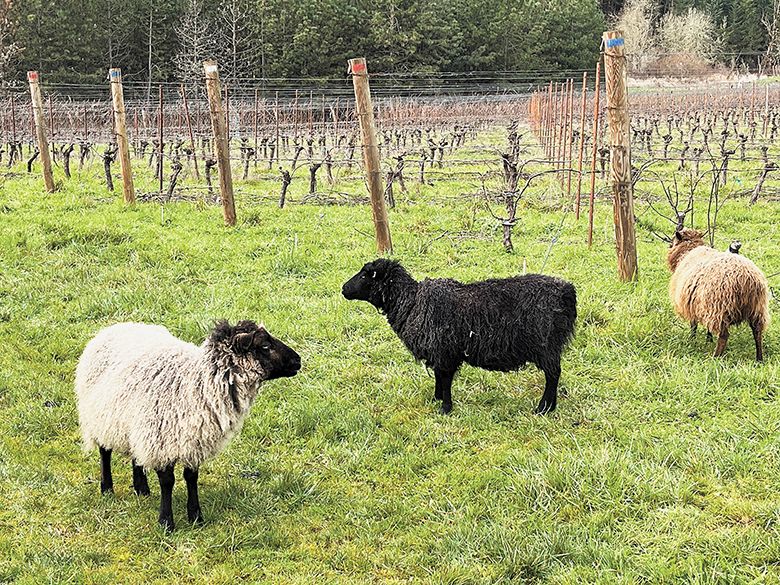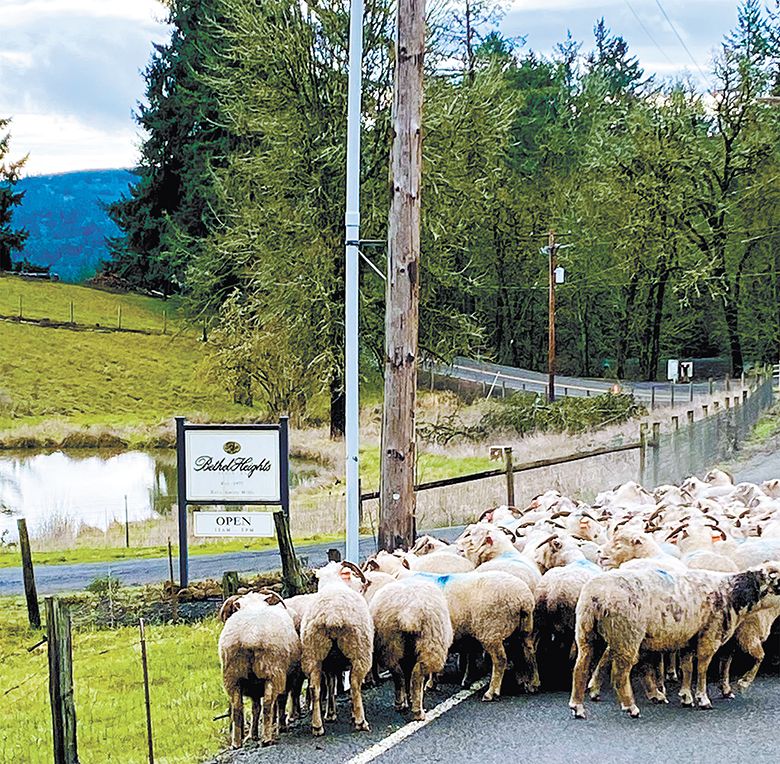Not a Baaaad Job
Sheep in the vineyards



By Gail Oberst
On sunny days about a month before budbreak, more than 100 sheep roam Björnson Vineyard’s grapevine rows in the hills above West Salem. The animals move slowly, devouring the ground cover, occasionally pausing to chew their cud. These are welcome guests, according to winery owner Mark Björnson. Two neighboring wineries– Bryn Mawr Vineyards and Bethel Heights Vineyard– hosted the flock before they hoofed it over to Björnson.
The sheep are not freeloading guests drifting from winery to winery in search of greener pastures. Instead, they’re in the vineyard to do a job. That is, if you can call eating, pooping and peeing “jobs.” Behind this pastoral scene in the Eola-Amity Hills AVA lies serious business of mowing, soil building and fertilization, all conducted by animals who make the task look easy.
For sheep, whose regular gig is producing wool, lambs and meat for their owner Jared Lloyd of Naked Grazing, this side gig is a cinch. At worst, the flock must take a hike or hitch a ride to the next vineyard. But at the end of the short journey are lush greens and grateful hosts.
It works out pretty well for the wineries as well as the sheep and their shepherds. The three wineries pay Naked Grazing to supply the flock and move it between the three wineries.
Lloyd said requests for his sheep have taken off this year. He had previously worked for another company providing sheep to vineyards, but when demand increased, he launched his own business. “My flocks will eat their way through a dozen vineyards and 2,000 acres this year,” he said.
The Horned Dorset sheep make up the bulk of his flocks. “It’s an older heritage breed with a hardy, maternal disposition, a good meat and milk provider that produces a coarse down wool great for weaving,” Lloyd said.
Grazing sheep in vineyards, an ancient practice, is finally catching on with both vineyard owners and wine drinkers who appreciate vintners’ attention to the environment, as well as the quality of their wines.
Björnson, who established the winery with wife, Pattie, in 2007, said he has long wanted to bring sheep into the picture. However, until he retired from his day job as a health insurance executive, hadn’t had the time to arrange it.
DIGESTING THE SCIENCE
Plenty of research, including some from Oregon State University, supports the practice of grazing ground cover in the vineyard. Studies show soil diversity created by grazing increases the quality of wine by improving a plant’s ability to use nutrients. Grazing increases phenols and pigments– the stuff of delicious wine. Other regenerative practices also accompany grazing. Björnson has never tilled the vineyard, and doesn’t irrigate, saying he aims to farm sustainably.
Usually, wineries use cover crops, mowing and fertilization to achieve these results, but tractors in the wet Northwest winter vineyards can compact soil. “The combination of sheep and cover crops make it possible to build the soil while reducing erosion,” Björnson said. There are additional benefits: studies prove grazing can also reduce invasive species and while increasing the water-holding capacity of soil, making it more resistant to drought.
But Alexis Bame, self-proclaimed “wine fairy” of the Björnson tasting room, ranks lambs at the top of her list of benefits. Many of the ewes transported from Bethel Heights Vineyard were pregnant and, most likely, will deliver during their stay there.
“We’re going to have babies,” she said excitedly.
Kate Crow, sales manager at Bethel Heights, is also a sheep cheerleader: “The sheep did an excellent job of ‘mowing’ our vineyard. They were fun to watch move around from area to area. Customers were intrigued with them and we relished the opportunity to educate folks on our regenerative farming practices.”
“Our fluffy friends played a pivotal role in maintaining our vineyard’s health, captivating the hearts of our staff and visitors, and creating a unique tasting experience,” said Krista Lauer, vice president of hospitality at Bryn Mawr Vineyards.
SHEEP SHARE IS BORN
The flock is not a permanent fixture at the three wineries. This year, the first for the three who call their project a “Sheep Share,” the flocks stayed for a few weeks in January at Bryn Mawr, before ambling to the adjacent Bethel Heights. The longest distance to Björnson from Bethel Heights– slightly more than three miles– was considered too much for the pregnant “madams,” so they were given a ride in the Naked Vineyard trailer.
“The name ‘Sheep Share’ is a play on a traditional wine club share, as the program benefits visitors and members of all three wineries,” Lauer said. While the sheep were onsite, club members received complimentary tastings and discounts on bottle purchases. “It was a wonderful avenue to increase traffic and visibility as well as educate our members about the benefits of sheep grazing,” said Lauer.
While the Sheep Share wineries have bid adieu to their flocks until next year, some Oregon wineries own and manage permanent flocks of sheep, goats and other grazers year-round.
Other sheepish wineries:
• Antiquum Farm
• Cristom Vineyard
• Johan Vineyard
• Left Coast Estate
• Native Flora
• Soter Vineyards
• Troon Vineyard
This list is growing as customers flock to see the sheep and taste the results of regenerative farming in Oregon wines.
Gail Oberst has been a Northwest writer, editor and publisher for decades. Among her favorite gigs was business editor for the News-Register, and editor pro temp for three months for the Oregon Wine Press. Inspired by the OWP, she founded the Oregon Beer Growler with her family, later selling it to Oregon Lithoprint. She continues to edit and write a wide range of articles for magazines, and weekly and regional newspapers. Recently, she published her first fiction novel, Valkyrie Dance, available on Amazon, and is working on her second, San Souci. She lives with her husband, Michael Cairns, a retired ecologist, in Independence, Oregon. They have four grown children and seven grandchildren.








